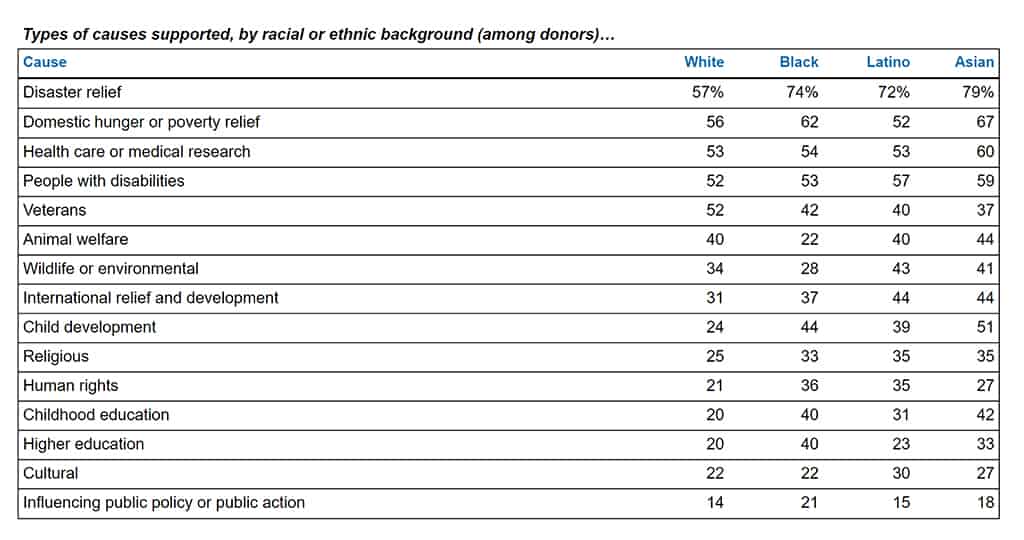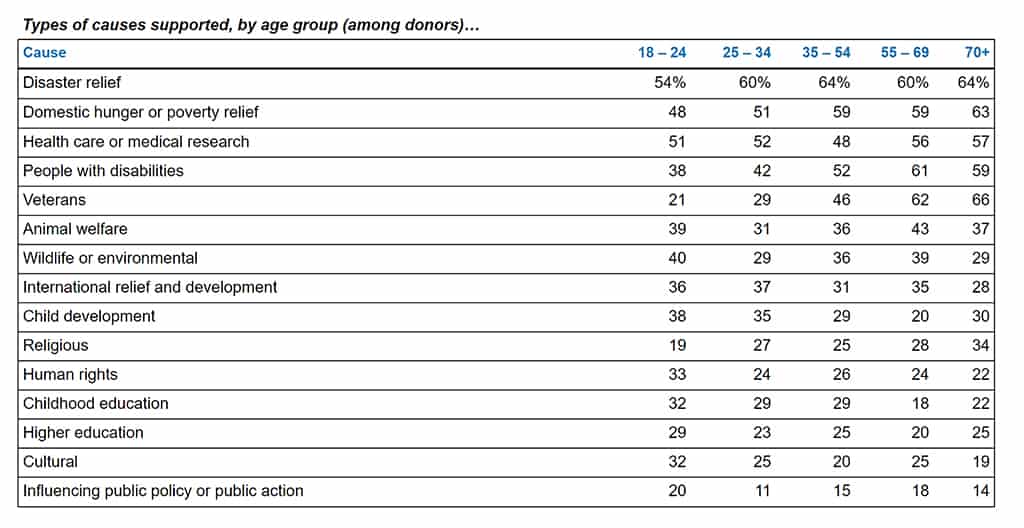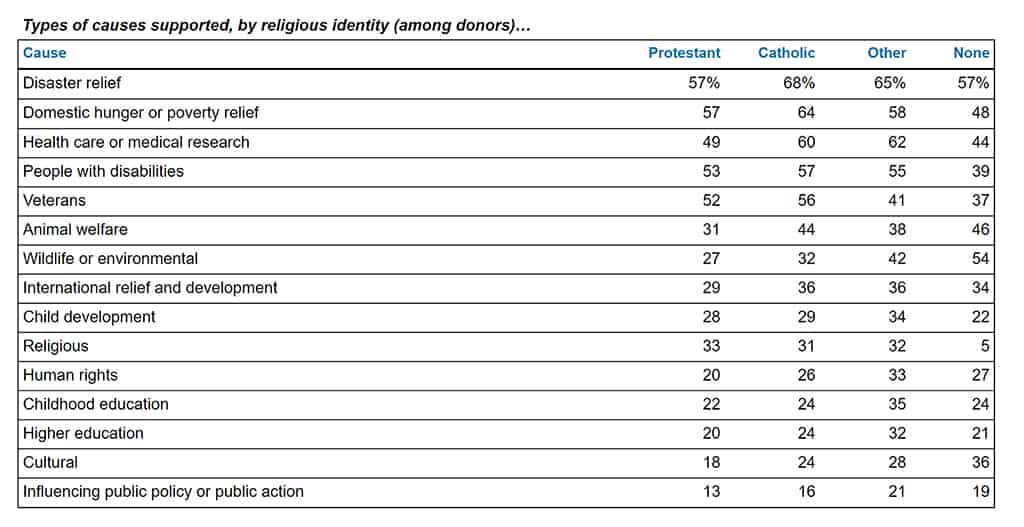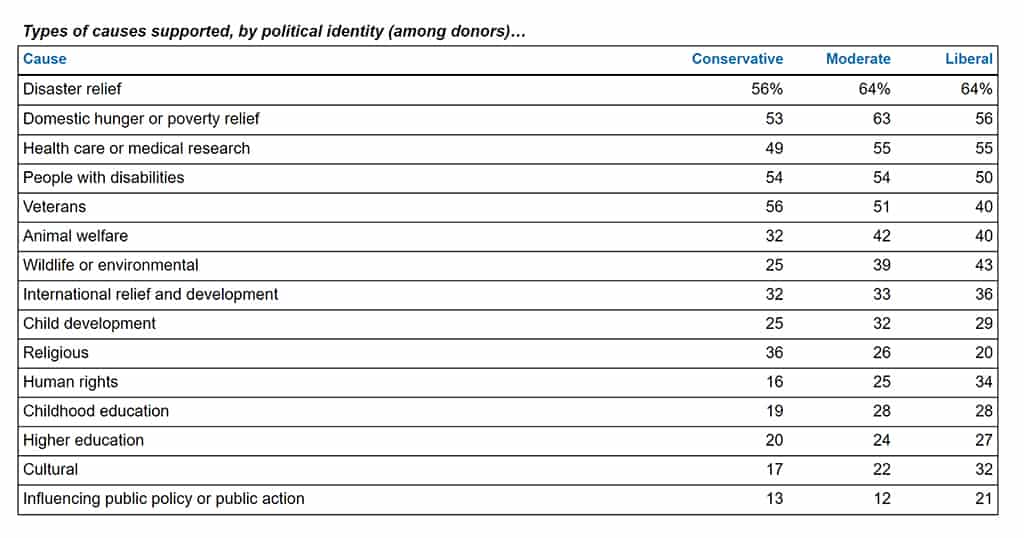Religious Americans often do not support specifically religious charitable causes
A recent study shows only a minority of religious donors support specifically religious work through non-profit organizations. The study also shows Black donors are twice as likely as White donors to support higher education. And the causes people choose to support are often quite dependent on their political views.
These findings are from Heart of the Donor, an in-depth study commissioned by Russ Reid Company of Pasadena, California, and conducted by Grey Matter Research & Consulting of Phoenix, Arizona.
“Most of the reports about the causes people give money to classify that giving by type of organization, but many organizations do more than one type of work,” explained Ron Sellers, president of Grey Matter Research. “A poverty relief organization may also advocate for public policy, while a medical research organization may have an arm that focuses on education. It can also be difficult to classify some organizations – is a Catholic school classified as religion, or education? So in this study we asked donors what kinds of causes they support, not what kinds of organizations – and we let donors decide these definitions according to how they perceive the work being done.”
“The study findings show strong differences in what kinds of people gravitate toward what kinds of charitable work,” said Lisa McIntyre, Senior Vice President of Russ Reid Company and a key part of the study. “The study also exploded some myths within the fundraising world.”
Heart of the Donor was conducted by telephone and online among a nationally representative sample of 2,005 American adults, in both English and Spanish. The study explores how Americans interact with nonprofit organizations. “Donors” refers to people who had made a financial contribution to a nonprofit organization other than a church or place of worship in the 12 months prior to the study.
One of the myths that proved to be untrue is that religious people only support specifically religious causes. Among donors who attend religious worship services on a regular basis, just 41% supported a cause they described as “religious,” other than any contributions they made to a place of worship. In fact, donors who attend religious services are more likely to have given toward disaster relief (68%), domestic hunger or poverty relief (66%), helping people with disabilities (56%), health care or medical research (54%), and veterans’ causes (52%) than they are to have supported specifically religious work.
Sellers cautioned that these numbers reflect how donors think of the work that’s being done, and not how various experts might categorize it. “It’s possible some religious donors are supporting disaster relief or domestic hunger through overtly religious organizations, but that’s not how they’re thinking of the work that’s being done,” he noted. “However, only 18% of donors who regularly attend worship services prefer supporting organizations which have their religious beliefs as a major part of everything they do, and 28% prefer organizations that have a religious background but which are not necessarily conducting religious work. Add in the fact that just 21% of Americans who financially supported a place of worship in the last year also gave to a religious cause through a non-profit, and it’s clear that a majority of religious donors are not actively seeking to support specifically religious work.”
The study also demonstrates that there are substantial differences in the kinds of charitable work different types of donors support. Political liberals are more likely than conservatives to put their donor dollars toward animal welfare, the environment, human rights, education, cultural, and public policy causes, while political conservatives are more likely to give toward veterans and religious causes.
Younger donors favor human rights, child development, childhood education, and cultural causes more than do older donors, while older donors are more likely than younger ones to support domestic hunger and poverty, religious, disabilities, and particularly veterans’ causes.
Other differences by cause:
- Disaster relief (61% of all donors): less likely to receive support from Caucasians, political conservatives, and people in the West than from other groups, but more likely to be supported by women, Spanish-speakers, people born outside the United States, college graduates, suburban and urban residents, donors with children in the household, and those who also support and/ or attend a place of worship (particularly Catholics).
- Domestic hunger or poverty relief (57% of all donors): a favorite or women, Asians, political moderates, people age 40 or older, those who also support and/or attend a place of worship, and especially a favorite of Catholics. Less likely to be supported by people with no particular religious identification.
- Healthcare or medical research (53% of all donors): more likely to receive support from women, married donors, suburban residents, college graduates, and donors from the Northeast. Far more likely to receive support from very high-income households than from very low-income households.
- People with disabilities (53% of all donors): more likely to get funding from donors who are 40 or older, who financially support and/or attend a place of worship, who identify themselves with a religious group of any type, and who have never attended college.
- Veterans (50% of all donors): a favorite of Caucasians and those who were native-born to the U.S., as well as people earning under $30,000 per year, less educated donors, married donors, people who attend and/or support a place of worship, and those who have no children in the household. Far more likely to be supported by people 55 and older than by those under 40, and far less likely to be supported by political liberals and urban residents than by other Americans.
- Animal welfare (38% of all donors): especially unlikely to be supported by Blacks, urban residents, Protestants, and donors who also give to and/or attend a place of worship. Most popular among people in the 45 – 69 age group and political moderates and liberals.
- Wildlife or environment (35% of all donors): more likely to be supported by Latinos and Asians, as well as people who are either under 25 or 40 – 64 years old, donors from households earning $60,000 per year or more, and those who do not financially support a place of worship or attend religious services. Political conservatives are far less likely to support this cause than are moderates or liberals, as are self-described Protestants or Catholics.
- International relief and development (33% of all donors): a particular favorite of Latinos (especially Spanish-speakers) and Asians, people born outside the United States, those who attend and/or financially support a place of worship, college graduates, and urban or suburban residents.
- Child development (28% of all donors): supported by a greater proportion of Blacks, Asians, and Hispanics (especially Spanish-speakers), people born outside the U.S., those living in the South, donors with children in the household, and those who also support and/or attend a place of worship. Less likely to receive support in the 55 – 69 age group than among other ages, and among people living in small towns or the suburbs as opposed to rural or urban residents.
- Religious (27% of all donors): less likely to be supported by Caucasians than by other ethnic groups, and by donors under age 25, those who are not married, and those living in the Northeast. Four times as likely to receive gifts from those who also support a place of worship as from those who do not, as well as far more likely to be supported by those who regularly attend religious services, and who are politically conservative.
- Human rights (25% of all donors): especially likely to be supported by Blacks and Latinos (particularly Spanish-speakers), as well as donors under age 25, those who are not married, urban and suburban residents, and political moderates and particularly liberals.
- Childhood education (25% of all donors): a higher proportion of donors are Asian, Black, or Hispanic, speak Spanish, were born outside the U.S., are under age 55, have children in the household, attend and/or financially support a place of worship, and earn at least $60,000 annually. People from religious perspectives other than Catholic or Protestant are more likely than others to support this cause, as are political moderates and liberals, as well as residents of rural and urban areas.
- Higher education (23% of all donors): a favorite of men, Blacks, Asians, donors from households earning at least $60,000 per year, people who also supported a place of worship and/or who attend worship services regularly, those with a college degree, and political moderates and liberals.
- Cultural (23% of all donors): a particular favorite of donors under age 25, people from households with at least $60,000 of annual income, college graduates, urban residents, political liberals, and those who have no specific religious identification.
- Influencing public policy (16%): more likely to be supported by men, more educated individuals, political liberals, those who do not self-identify as Protestants, and people living in an urban or suburban area.
McIntyre noted that non-profit organizations can’t look at all donors as being the same. “Many non-profits conduct a variety of different kinds of work, and these kinds of work may have donors who look very different from each other. A homeless shelter might have one type of person supporting its drug rehabilitation program and another type of person supporting its crisis pregnancy program, for instance. It’s important that donors to any given organization not be all lumped together, but that organizations understand that the people they’re talking to – both existing and potential donors – may vary quite a bit depending on the kind of work that’s being done.”
Study Details:
Heart of the Donor was commissioned by Russ Reid Company and conducted by Grey Matter Research & Consulting. The study was conducted using a demographically representative and behaviorally balanced national online research panel, along with telephone data collection among people who do not use the Internet. The sample size of 2,005 people has a potential sampling error of ±2.2 percentage points at the 95% confidence interval. The study was conducted in both English and Spanish. Data was collected May 2010.
Grey Matter Research has been solving the information and research needs of for-profit companies and non-profit organizations since 1996. Formerly Ellison Research, the company has worked with a lengthy list of national donor-supported organizations over the last 15 years, along with corporate clients such as Chevrolet, Macy’s Department Stores, Navistar, and Coca-Cola. Grey Matter Research offers sophisticated qualitative and quantitative research techniques to uncover details that make a tangible difference for clients.
Russ Reid is the preferred fundraising partner of over 200 growth-oriented non-profit organizations across the United States and Canada. The company has a 46-year proven track record of acquiring high value donors and dollars using all available media, including online, direct mail, print, television, radio and catalog, as well as federal funding and advocacy. Russ Reid helps clients extract maximum value from these donors through sophisticated donor segmentation, offer development, and donor retention strategies.




